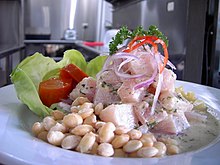 Peruvian ceviche | |
| Course | Main course, appetizer |
|---|---|
| Place of origin | Peru |
| Main ingredients | Seafood, lime or lemon |
| Other information | Cooked or marinated (raw) |
Ceviche is a seafood dish of Peruvian origin that is typical of Latin American cuisine. Its name is possibly derived from either the Quechua word for "fresh fish" (siwichi) or the Andalusian Arabic word for "meat cooked in vinegar" (assukkabáǧ). The dish primarily consists of seafood that is marinated in citrus juice. Additional ingredients and garnishes vary throughout Latin America, the exact recipe depending on local culinary traditions.
Scholars and renown chefs agree that ceviche was invented in colonial Peru, with the arrival of citrus fruits and onions from the Columbian exchange in the 16th century. In pre-Columbian Peru, indigenous civilizations, reliant on marine resources from the highly-productive Humboldt Current ecosystem, marinated seafood using the fermented juices (known as chicha) from cultigens and wild plants such as the banana passionfruit. The oldest-known mention of the dish in the historical record dates to 1820, when "seviche" is mentioned as a food in "La Chicha," a Peruvian patriotic song advocating the country's independence from Spain.
Ceviche is served as either an appetizer or a main dish. Because the dish is eaten raw, meaning not cooked with heat, it must be prepared fresh and consumed immediately to minimize the risk of food poisoning. As part of the Nuevo Latino gourmet culinary trend, ceviche has been increasingly popular in the United States since the early 1990s. Due to the dish's historical significance, Peru decreed a national cultural heritage law instating ceviche as a "Cultural Patrimony of the Nation" in 2004. Peru celebrates a yearly public holiday in honor of the dish on June 28.
